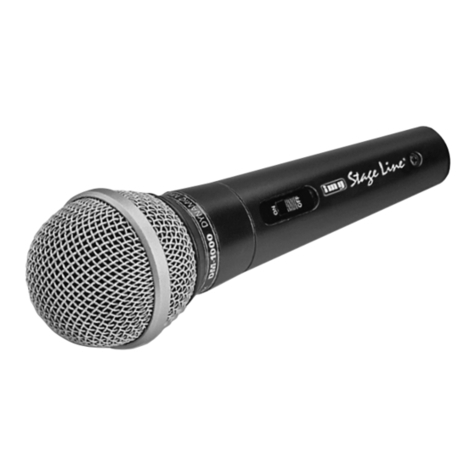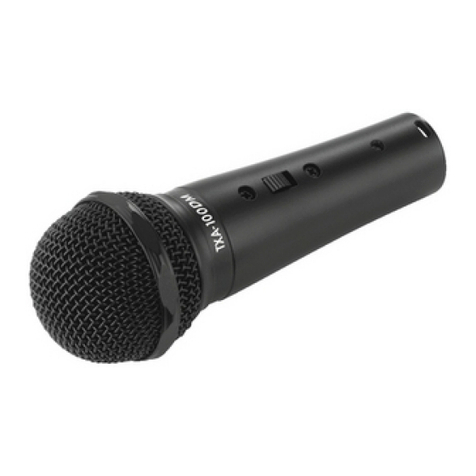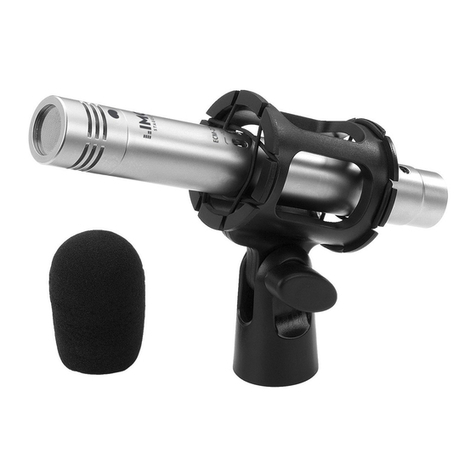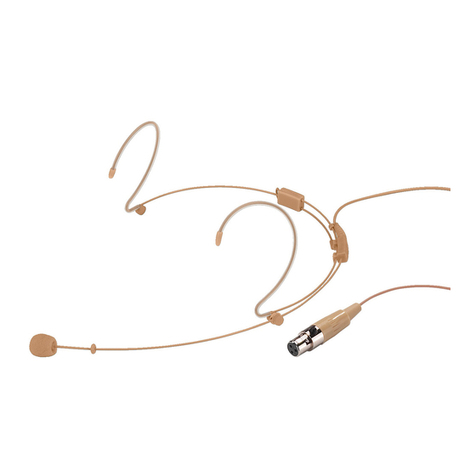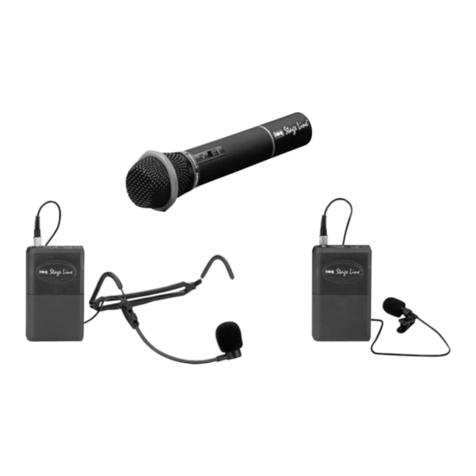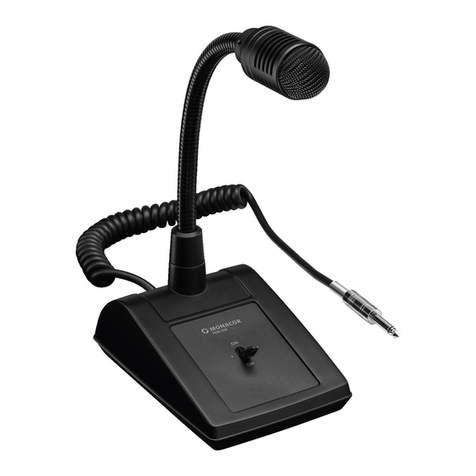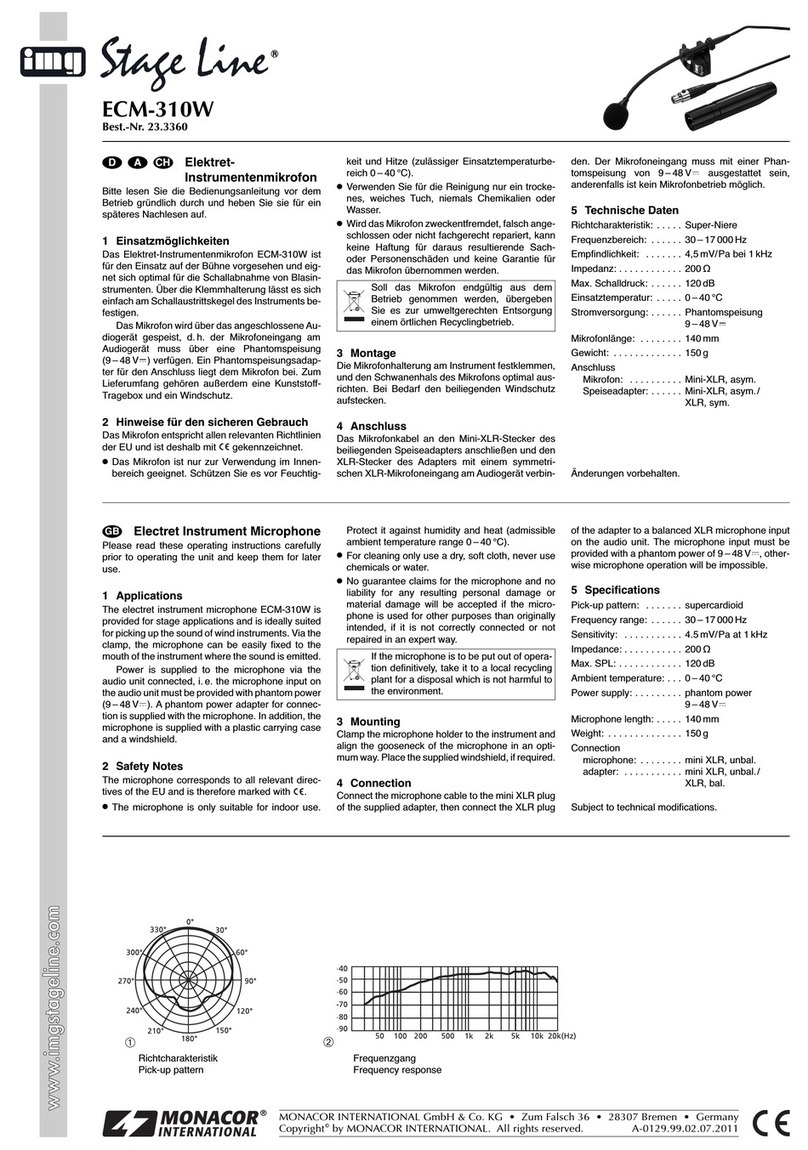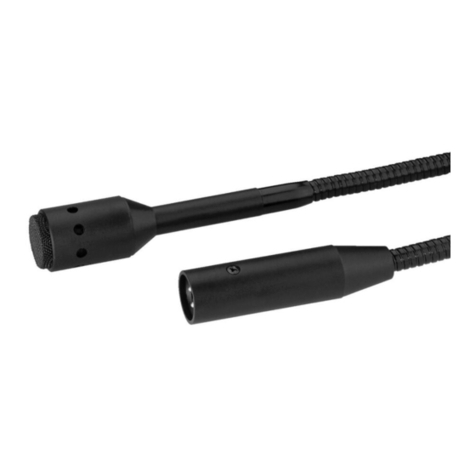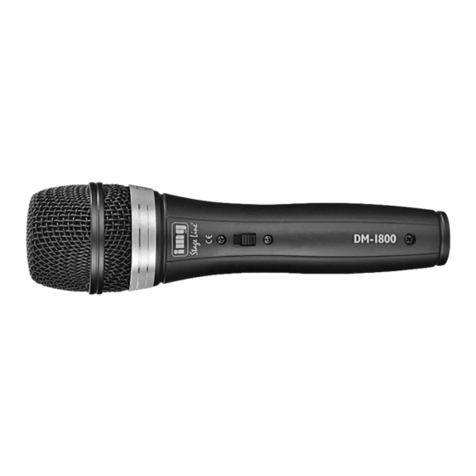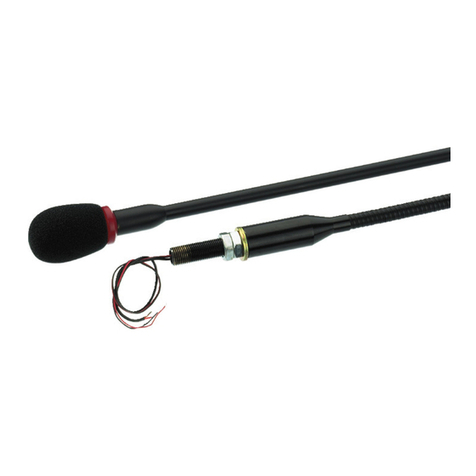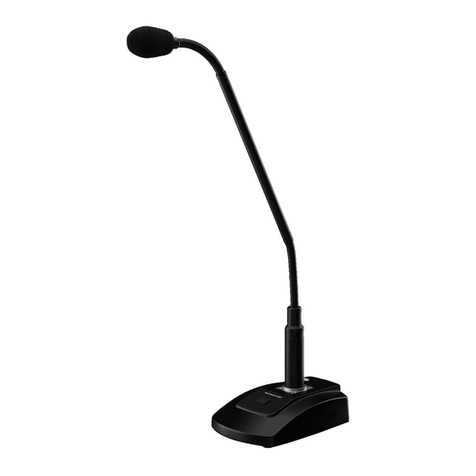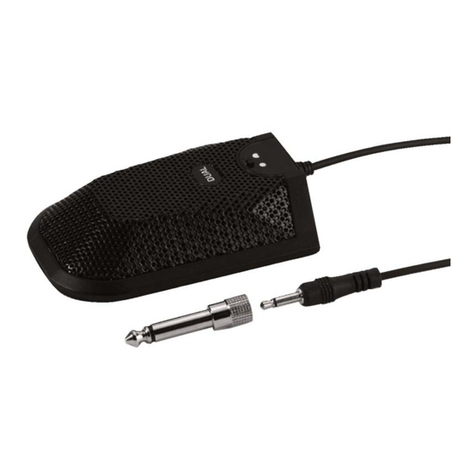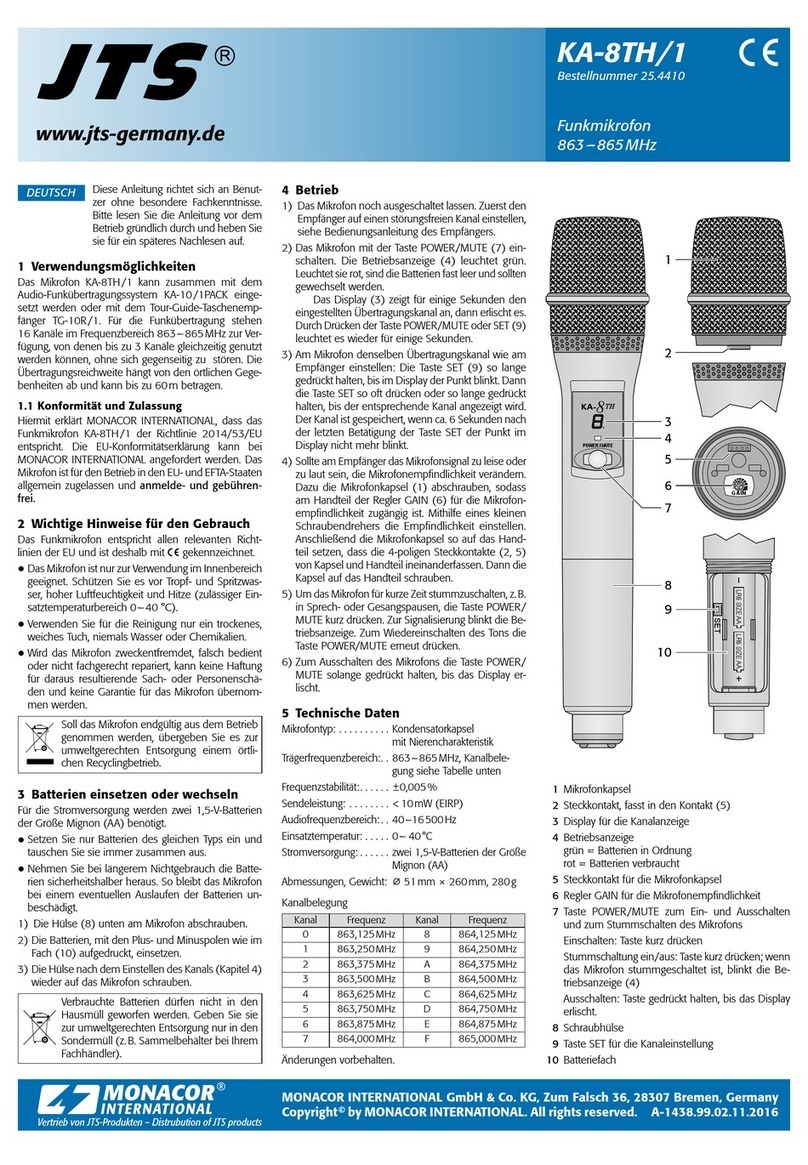Microfono direzionale a elettrete
Vi preghiamo di leggere attentamente le presenti istru-
zioni prima dell’uso e di conservarle per un uso futuro.
1Possibilità d’impiego
Questo microfono direzionale è adatto in modo partico-
lare per avvisi, conferenze e altre trasmissioni di lingua
parlata, dove è richiesto un microfono fisso. Può essere
sistemato direttamente su un contatto XLR per microfo-
no, come p. es. nel caso dei mixer con un contatto del
genere sul pannello frontale. Oppure, insieme alla base
per microfoni DMS-1 o DMS-3 dal programma di
MONACOR può essere usato come microfono da tavo-
lo. Per il suo funzionamento è richiesta un’alimentazio-
ne phantom (9 – 48 V).
2Avvertenze di sicurezza
Il microfono è conforme a tutte le direttive richieste
dell’UE e pertanto porta la sigla .
●Far funzionare l’apparecchio solo all’interno di locali e
proteggerlo dall’acqua gocciolante e dagli spruzzi
d’acqua, da alta umidità dell’aria e dal calore (tempe-
ratura d’impiego ammessa fra 0 e 40 °C).
●Per la pulizia usare solo un panno morbido, asciutto;
non impiegare in nessun caso acqua o prodotti chimici.
●Nel caso d’uso improprio, di collegamenti sbagliati o di
riparazione non a regola d’arte del microfono, non si
assume nessuna responsabilità per eventuali danni
consequenziali a persone o a cose e non si assume
nessuna garanzia per il microfono.
3Messa in funzione
1) Montare la spugna antivento in dotazione sul micro-
fono.
2) Inserire il microfono nell’ingresso XLR per microfono
dell’apparecchio audio (p. es. del mixer) oppure della
base per microfono. L’ingresso per il microfono deve
Se si desidera eliminare il microfono defini-
tivamente, consegnarlo per lo smaltimento
ad un’istituzione locale per il riciclaggio.
mettere a disposizione un’alimentazione phantom
(9 – 48 V). Se non ne dispone, collegare il microfono
con l’apparecchio audio servendosi di un alimentato-
re phantom separato (p. es. EMA-3, EMA-200, EMA-
400 dal programma di MONACOR).
3) Orientare il microfono in modo ottimale.
4Dati tecnici
Tipo di microfono: . . . . . back-elettrete
Caratteristica direzionale: iper-cardioide/delta
Gamma di frequenze: . . 50 – 18 000 Hz
Sensibilità:. . . . . . . . . . . 10 mV/Pa con 1 kHz
Impedenza: . . . . . . . . . . 250 Ω
Max. pressione sonora:. 125 dB
Alimentazione: . . . . . . . phantom 9 – 48 V
Dimensioni, peso
EMG-250P:. . . . . . . . Ø 19 mm x 250 mm, 120 g
EMG-330P:. . . . . . . . Ø 19 mm x 330 mm, 125 g
Collegamento:. . . . . . . . XLR, simmetrico
Con riserva di modifiche tecniche.
Micrófono Electret Direccional
Por favor lea estas instrucciones cuidadosamente antes
de utilizar la unidad y consérvelas para usos posteriores.
1Aplicaciones
Este micrófono direccional está especialmente diseñado
para anuncios, lecturas, u otras transmisiones de habla
que requieran un micrófono estático. Puede ser directa-
mente colocado en conexiones de micrófono XLR, p. ej.
mesas de mezclas a condición que tengan una conexión
en la parte delantera. Alternativamente, junto con la
base de micrófono DMS-1 o DMS-3 de la gama de pro-
ductos de MONACOR, puede ser usado como micrófo-
no de mesa. Para el funcionamiento del micrófono, se
necesita una alimentación phantom (9 – 48 V).
2Notas de seguridad
El micrófono corresponde a todas las Directivas reque-
ridas por la UE y por eso está marcada con .
●La unidad sólo está indicada para su uso en interior.
Protéjala de proyecciones de agua, salpicaduras,
humedad elevada del aire y calor (temperatura de
funcionamiento admisible 0 – 40 °C).
●Para la limpieza use sólo un paño seco y suave; no
use nunca agua o productos químicos.
●No se aceptará ninguna reclamación para el micrófo-
no ni responsabilidad alguna en caso de daños per-
sonales o materiales resultantes si el micrófono se
usa para otros fines que los que se idearon original-
mente, si no se conecta correctamente, o si no se
repara de manera experta.
3Funcionamiento
1) Coloque en el micrófono el protector para el vien-
to/anti-ruido entregado.
2) Inserte el micrófono en la entrada de micrófono XLR
de la unidad de audio (por ejemplo una mesa de mez-
clas) o en la base del micrófono. La entrada del micró-
Si la unidad debe ser puesta fuera de fun-
cionamiento definitivamente, llévela a un
centro de reciclaje local para su eliminación
no contaminante para el medio ambiente.
fono debe estar provista de una alimentación phan-
tom (9 – 48 V). Si no, conecte el micrófono mediante
una unidad de alimentación phantom separada (p. ej.
la EMA-3, EM-200, EMA-400 de MONACOR) a la
unidad de audio.
3) Ajuste el micrófono de una manera óptima.
4Características técnicas
Tipo de micrófono: . . . . back electret
Característica:. . . . . . . . hypercardioide/“lobar”
Índice de frecuencia:. . . 50 – 18 000 Hz
Sensibilidad: . . . . . . . . . 10 mV/Pa a 1 kHz
Impedancia: . . . . . . . . . 250 Ω
Presión sonora máxima: 125 dB
Alimentación: . . . . . . . . alimentación phantom
9–48V
Dimensiones, peso
EMG-250P:. . . . . . . . Ø 19 mm x 250 mm, 120 g
EMG-330P:. . . . . . . . Ø 19 mm x 330 mm, 125 g
Conexión: . . . . . . . . . . . XLR, simétrico
Sujeto a modificaciones técnicas.
EMG-330P
EMG-250P
Copyright©by MONACOR INTERNATIONAL GmbH & Co. KG, Bremen, Germany. All rights reserved. A-0530.99.01.01.2006
®
Elektretowy mikrofon kierunkowy
Prosimy o uważne przeczytanie poniższej instrukcji
przed użyciem urządzenia, oraz o zachowanie tekstu
do wglądu.
1Zastosowanie
Mikrofon kierunkowy EMG-250P/EMG-330P jest
przeznaczony do przetwarzania sygnału mowy, np.
komunikatów słownych, wykładów, czy transmisji
mowy innego rodzaju, dla których wymagany jest
mikrofon stacjonarny. Mikrofon kierunkowy można
podłączyć bezpośrednio do złączy mikrofonowych
XLR, np. do miksera, który jest wyposażony w tego
typu złącze na panelu frontowym. EMG-250P/EMG-
330P może być również stosowany jako mikrofon pul-
pitowy, w połączeniu z mikrofonową podstawką
stołową z ofert firmy MONACOR: DMS-1 lub DMS-3.
Do poprawnego funkcjonowania mikrofon elektretowy
wymaga zasilania fantomowego (9 – 48 V).
2Bezpieczeństwo użytkowania
Urządzenie spełnia wymogi norm obowiązujących w
Unii Europejskiej, jest zatem oznaczone symbolem .
●Urządzenie przeznaczone jest do użytku jedynie
wewnątrz pomieszczeń. Należy chronić je przed
bezpośrednim kontaktem z wodą, przed działaniem
wilgoci oraz wysokiej temperatury (dopuszczalna
temperatura otoczenia pracy to 0 – 40 ºC).
●Do czyszczenia urządzenia należy używać suchej,
miękkiej tkaniny; nie wolno stosować wody, ani che-
micznych środków czyszczących.
●Producent ani dostawca nie ponoszą odpowiedzial-
ności za wynikłe szkody (uszkodzenie sprzętu lub
obrażenia użytkownika), jeśli urządzenie było uży-
wane niezgodnie z przeznaczeniem, lub jeśli zostało
nieprawidłowo podłączone, bądź poddane nieau-
toryzowanej naprawie.
3Obsługa urządzenia
1) Należy nałożyć na mikrofon osłonę przeciwwietrzną.
2) Należy podłączyć mikrofon do wejścia XLR urządze-
Jeśli urządzenie ma zostać ostatecznie
wycofane z użycia, należy przekazać je do
punktu utylizacji odpadów, aby uniknąć
zanieczyszczenia środowiska.
nia audio (np. miksera) lub do mikrofonowej podsta-
wki stołowej. Wejście mikrofonowe musi być wypo-
sażone w napięcie fantomowe (9 – 48 V). W innym
wypadku należy podłączyć mikrofon do urządzenia
audio przez zewnętrzny zasilacz fantomowy (np. z
oferty firmy MONACOR EMA-3, EM-200, EMA-400).
3) Należy wyregulować optymalne ustawienie mikro-
fonu.
4Dane techniczne
Typ mikrofonu: . . . . . . elektretowy typu “back”
Charakterystyka
mikrofonu: . . . . . . . . . hypercardioida/lobar
Pasmo przenoszenia: 50 – 18 000 Hz
Czułość: . . . . . . . . . . . 10 mV/Pa/1 kHz
Impedancja:. . . . . . . . 250 Ω
Maks. SPL:. . . . . . . . . 125 dB
Zasilanie: . . . . . . . . . . napięcie fantomowe 9 – 48 V
Wymiary, waga
EMG-250P: . . . . . . Ø19 mm x 250 mm, 120 g
EMG-330P: . . . . . . Ø19 mm x 330 mm, 125 g
Połączenie: . . . . . . . . XLR, symetryczne
Z zastrzeżeniem możliwości zmian.
E
I
PL

